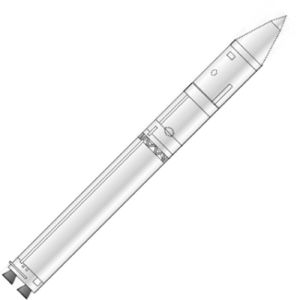
Home - Search - Browse - Alphabetic Index: 0- 1- 2- 3- 4- 5- 6- 7- 8- 9
A- B- C- D- E- F- G- H- I- J- K- L- M- N- O- P- Q- R- S- T- U- V- W- X- Y- Z
RLA
 RLA-120 Credit: © Mark Wade |
Status: Study 1974.
Glushko, new head of NPO Energia, briefed his new launch vehicle family to the VPK Military Industrial Commission on 13 August 1974. These met the requirements of the Ministry of Defense as described in 1973 in Plan Poisk and would replace the failed N1 and all existing launch vehicles. As required by the Ministry of Defense, they used only non-toxic, inexpensive Lox/Kerosene propellants; the various launch vehicles were modular, and used common engines and rocket bodies. The basic engine would be a four-chamber design with a vacuum thrust of 1,200,000 kgf. The modules had a gross mass of about 800 metric tons each, were six meters in diameter and about thirty meters long.
The new design family was called RLA - Rocket Flight Apparatus.
The RLA-120 was the smallest member, with a gross lift-off mass of 980 metric tons, using a single module with a 150 metric ton upper stage, payload 30 metric tons. First flight was to be in 1979, with POS modules to be assembled in orbit in the 1980-1981 period.
The RLA cluster method would allow the modules to be built in the factory and thoroughly tested individually without risking the entire launch vehicle. Total cost of the development program was put at 12.5 billion rubles.
The members of the VPK met the proposal with considerable skepticism. The final decision was that the plan had to be reworked. Brezhnev, Keldysh, and Ustinov would insist in the reformulation that the Lox/LH2 technology and capabilities of the US space shuttle had to be duplicated. The end result would be smaller Zenit and Energia launch vehicles and Buran space shuttle, with which neither the military or the Soviet engineering community was happy.
| RLA-120 Russian heavy-lift orbital launch vehicle. Medium booster concept with a payload to low earth orbit of 30 metric tons using the RLA-120 core and a 150 metric ton upper stage. Glushko proposed that the RLA-120 would boost reconnaissance satellites and modules of his POS Permanent Orbital Station into a sun synchronous orbit beginning in 1979. The government rejected the RLA concept, but this design led directly to the successful Zenit-2 booster. |
| RLA-150 Russian heavy-lift orbital launch vehicle. Super-booster concept with a payload to low earth orbit of 250 metric tons using six modules as the first stage and the RLA-120 core. Glushko proposed that the booster could launch a Soviet manned Mars landing by 1983. The government rejected the RLA concept, but it did lead to the Energia booster of the 1980's. |
| RLA-135 Russian heavy-lift orbital launch vehicle. Heavyweight booster concept with a payload to low earth orbit of 100 metric tons using two modules as the first stage and the RLA-120 core. Glushko proposed that the booster could launch a Soviet manned lunar landing by 1981. The government rejected the RLA concept, but it did lead to the Zenit-2 and Energia boosters of the 1980's. |
Family: heavy-lift, orbital launch vehicle. Country: Russia. Agency: Korolev bureau. Bibliography: 367, 445.
1974 August 13 - . Launch Vehicle: RLA.
- Glushko briefed his new RLA launch vehicle family to the VPK Military Industrial Commission - .
Nation: Russia.
These RLA - Rocket Flight Apparatus - met the requirements of the Ministry of Defence as described in 1973 in Plan Poisk and would replace the failed N1 and all existing launch vehicles. As required by the Ministry of Defence, they used only Lox/Kerosene propellants; the various launch vehicles were modular, and used common engines and rocket bodies. The members of the VPK met the proposal with considerable scepticism. The final decision was that the plan had to be reworked. Additional Details: here....
Back to top of page
Home - Search - Browse - Alphabetic Index: 0- 1- 2- 3- 4- 5- 6- 7- 8- 9
A- B- C- D- E- F- G- H- I- J- K- L- M- N- O- P- Q- R- S- T- U- V- W- X- Y- Z
© 1997-2019 Mark Wade - Contact
© / Conditions for Use